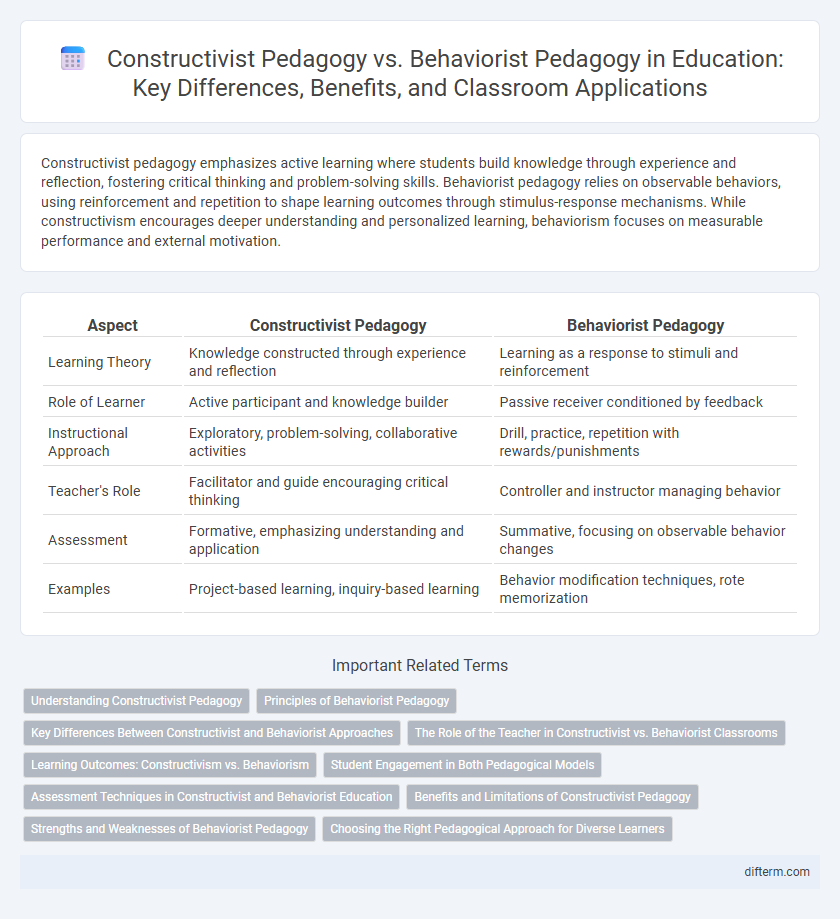Constructivist pedagogy emphasizes active learning where students build knowledge through experience and reflection, fostering critical thinking and problem-solving skills. Behaviorist pedagogy relies on observable behaviors, using reinforcement and repetition to shape learning outcomes through stimulus-response mechanisms. While constructivism encourages deeper understanding and personalized learning, behaviorism focuses on measurable performance and external motivation.
Table of Comparison
| Aspect | Constructivist Pedagogy | Behaviorist Pedagogy |
|---|---|---|
| Learning Theory | Knowledge constructed through experience and reflection | Learning as a response to stimuli and reinforcement |
| Role of Learner | Active participant and knowledge builder | Passive receiver conditioned by feedback |
| Instructional Approach | Exploratory, problem-solving, collaborative activities | Drill, practice, repetition with rewards/punishments |
| Teacher's Role | Facilitator and guide encouraging critical thinking | Controller and instructor managing behavior |
| Assessment | Formative, emphasizing understanding and application | Summative, focusing on observable behavior changes |
| Examples | Project-based learning, inquiry-based learning | Behavior modification techniques, rote memorization |
Understanding Constructivist Pedagogy
Constructivist pedagogy centers on active learning where students build knowledge through experience and reflection, contrasting with behaviorist pedagogy's emphasis on stimulus-response conditioning and rote memorization. In constructivist classrooms, educators facilitate inquiry, collaboration, and problem-solving, fostering deeper conceptual understanding and critical thinking skills essential for lifelong learning. This approach aligns with cognitive development theories by Piaget and Vygotsky, highlighting how learners construct meaning in social and contextual environments.
Principles of Behaviorist Pedagogy
Behaviorist pedagogy centers on observable behaviors and reinforcement techniques, emphasizing stimulus-response associations to shape learning outcomes. Key principles include repetition, positive and negative reinforcement, and clear, measurable objectives to promote knowledge acquisition through external rewards or punishments. This approach contrasts with constructivist pedagogy by focusing on direct instruction and behavioral modification rather than learner-centered discovery.
Key Differences Between Constructivist and Behaviorist Approaches
Constructivist pedagogy emphasizes active learner engagement, where students build knowledge through experiences and reflection, fostering deep understanding and critical thinking. Behaviorist pedagogy centers on observable behaviors, using reinforcement and repetition to shape learning outcomes with clear, measurable objectives. Constructivism supports collaborative, learner-centered environments, while behaviorism relies on teacher-directed instruction and structured feedback mechanisms.
The Role of the Teacher in Constructivist vs. Behaviorist Classrooms
In constructivist classrooms, teachers act as facilitators, guiding students to build their own understanding through exploration and inquiry, while encouraging critical thinking and problem-solving skills. In contrast, behaviorist classrooms rely on teachers as authoritative figures who deliver direct instruction, reinforce desired behaviors through rewards and punishments, and emphasize measurable outcomes. This fundamental difference shapes classroom dynamics, student engagement, and learning processes.
Learning Outcomes: Constructivism vs. Behaviorism
Constructivist pedagogy promotes active learning through experience and reflection, resulting in deeper comprehension and critical thinking skills. Behaviorist pedagogy relies on reinforcement and repetition, often leading to improved memorization and task-specific performance. Learning outcomes in constructivism emphasize problem-solving and knowledge application, whereas behaviorism focuses on observable behavior changes and skill acquisition.
Student Engagement in Both Pedagogical Models
Constructivist pedagogy enhances student engagement by promoting active learning through exploration, collaboration, and critical thinking, enabling students to construct knowledge based on their experiences. Behaviorist pedagogy increases engagement by using reinforcement techniques such as rewards and repetition to shape desired behaviors and skills. Both models influence engagement differently, with constructivism fostering intrinsic motivation and behaviorism relying on extrinsic motivators.
Assessment Techniques in Constructivist and Behaviorist Education
Constructivist pedagogy emphasizes formative assessment techniques such as reflective journals, portfolios, and project-based evaluations to gauge students' understanding and promote critical thinking. Behaviorist pedagogy relies heavily on summative assessments like quizzes, multiple-choice tests, and standardized exams to measure observable learning outcomes and reinforce desired behaviors. The contrast highlights constructivism's focus on internal cognitive processes and behaviorism's emphasis on external performance metrics in educational assessment.
Benefits and Limitations of Constructivist Pedagogy
Constructivist pedagogy promotes active learning by encouraging students to build knowledge through experience, fostering critical thinking and deeper understanding. It benefits learners by enhancing engagement and promoting genuine problem-solving skills but may be limited by its reliance on student motivation and the challenge of assessing subjective learning outcomes. This approach contrasts with behaviorist pedagogy, which emphasizes observable behavior changes and structured reinforcement, often lacking the depth of cognitive development found in constructivist methods.
Strengths and Weaknesses of Behaviorist Pedagogy
Behaviorist pedagogy excels in providing clear, measurable learning outcomes through repetitive practice and reinforcement, making it effective for mastering foundational skills and routines. Its structured approach supports consistent behavior modification but often neglects critical thinking and creativity, potentially limiting deeper understanding and learner autonomy. The emphasis on external rewards can reduce intrinsic motivation, resulting in passive learning rather than active engagement.
Choosing the Right Pedagogical Approach for Diverse Learners
Constructivist pedagogy emphasizes learner-centered approaches, fostering critical thinking and knowledge construction through active engagement and collaboration. Behaviorist pedagogy focuses on observable behaviors and systematic reinforcement to shape learning outcomes, often using repetition and drills. Selecting the appropriate method depends on learner diversity, with constructivism benefiting exploratory and social learners, while behaviorism suits those requiring clear structure and immediate feedback.
constructivist pedagogy vs behaviorist pedagogy Infographic

 difterm.com
difterm.com